 By Robert Williamson
By Robert Williamson
(Published in Utah Fishing & Outdoors, Jan. 1992)
It was Oct 17 and we’d concluded the last cleanup on the Ogden River for the year. Gene Castellano and myself decided that our fly rods should accompany us on this project so we could get in some good fall fishing before the cold of winter showed up.
I had been studyingthe river for a week or so trying to determinewhat kind of hatches were coming off, and seeing how the high flows all summer may have affected the fish. I witnessed a pretty good blue-winged olive hatch coming off around noon that straggling on to about 2 pm. I had been experimenting with some comparadun style blue—wing olive patterns and felt pretty confident that I had come up with a winning pattern. I was also experimenting with the trailing shuck theory and had tied a few patterns to imitate this vulnerable time in a mayfly’s life.
After picking up several bags of trash, we decided it was time to fish. As we were putting on our waders and rigging up our rods, I expounded on the trailing shuck theory and showed Gene some of the patterns I had decided to try. I asked Gene if he would like to try some and he said he wouldjust tie on the old Royal Coachman and give it a float first. If he wasn’t picking up any fish alter a few casts he assured me he would give my pattern a try.
Working a relatively small stream side-by-side moving upstream takes a little patience and a little courtesy. Gene took the far side of the river and l the near. Each of us stayed on our own side of the stream and asked permission from one another to fish the other’s side when one or the other got hung up or had to tie on a new fly.
As we positioned ourselves in the first hole, we immediately saw fish rising at the tail of the pool. Gene had a better casting angle than I did so I stood back and watched as he laid out a perfect cast to the fish's position. His coachman landed on the water and began to dead-drift back, and I watched it and thought to myself that I would let him try a couple more casts before I took the brown with the more exact comparadun. Hardly had the thought cleared my mind when a good ’13»inch brown turned, swirled and inhaled his fly. The battle was on and Gene successfully played and landed the fish. A fluke! Must have been an awfully hungry fish, I was thinking.
I gave the comparadun a couple of floats down my side of the run with no results. 1 was sure Gene’s fish had spooked the rest or the trout in the hole and it was no use trying for them, Gene asked to give it one more shot on my side of the river, and I said it was all right. First cast a trout jumped at his Coachman but missed. He recast his fly into the same area and again hooked a decent fish.
After he played and releasedhis second fish, I said it was time to move to the next pool where I had spotted some more risers, Gene asked for one more cast down his side of the river before proceeding. Sure, I said, have at it. Again, Gene caught a fish.
It doesn't take me all that long to learn a lesson, but when Gene smilingly asked if I wanted to try a Coachman, I said no, I was experimenting and doing research. We moved to the next hole and this time it was my turn with the first cast I cast to the riser in the tail of the pool and finally caught about an 8-incher. Gene started to work his side of the water and again brought a nice fish to hand. He was able to take two more fish from this pool and I did not get another rise. This is how the afternoon went. In every hole Gene would take three fish to my one. After about the fifth hole I had concluded my research and experimentation and I asked Gene for one of those Royal Coachmans.
After all, there is only so much time for research!
